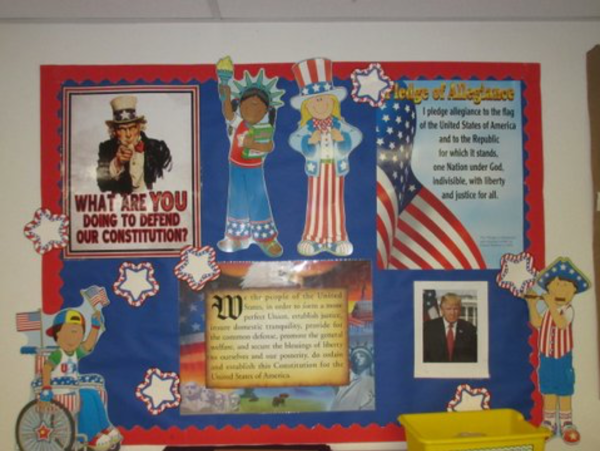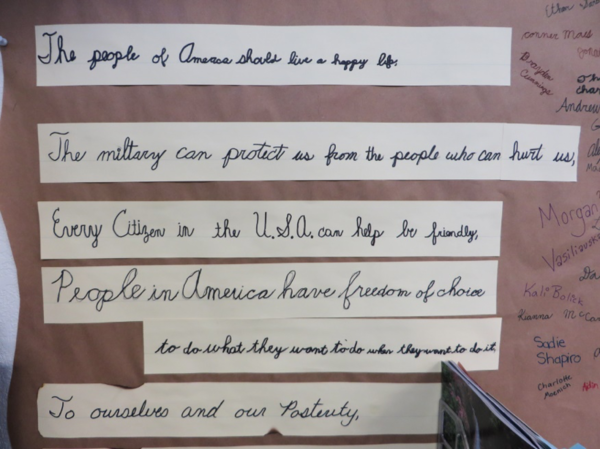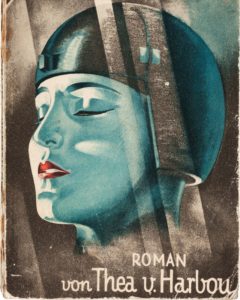 “You can tell a Benchmark kid. They love their country – they know why it’s special.” I asked Carole Challoner, one of the founders of this public charter school in Phoenix, how she teaches patriotism to her elementary students. The teachers do it by inspiring the kids with opportunities for gratitude, service, and patriotism. Carole explained how Benchmark does it in ten easy steps.
“You can tell a Benchmark kid. They love their country – they know why it’s special.” I asked Carole Challoner, one of the founders of this public charter school in Phoenix, how she teaches patriotism to her elementary students. The teachers do it by inspiring the kids with opportunities for gratitude, service, and patriotism. Carole explained how Benchmark does it in ten easy steps.
1. August. The school year begins with teaching the National Anthem and the Pledge of Allegiance. Many students coming in from other schools do not know them. Each morning, we play the national anthem over the P.A. system. A couple of students from kindergarten, then rotating up the grades through the year, go to the office and lead the Pledge over the P.A. system. The kids love being picked.
Lesson plans: Each grade learns the meaning of each stanza, what pledging means. They know what they are saying. “If I promise if I’m going to donate $2 of my allowance, that’s a pledge.” Allegiance is standing for something that is right. “To the flag” means you believe in what the flag stands for. They learn how the flag came about, part of beginning a new country.
2. September. We hold a school assembly outdoors and raise two new flags on 9/11 in remembrance. In preparation, each class learns patriotic songs, appropriate to the grade – “We Love America,” “Three Cheers for the Red, White, and Blue” and so on, different for each grade level.
 Reinforcement: At the end of the year, two students are recognized as “good citizens” and are given the flags to take home. It is a great honor. The teachers keep their eyes out for good citizenship – respect to teachers and fellow students, holding a door open for a teacher, cleaning up a mess in the playground without being asked, being kind to a fellow student.
Reinforcement: At the end of the year, two students are recognized as “good citizens” and are given the flags to take home. It is a great honor. The teachers keep their eyes out for good citizenship – respect to teachers and fellow students, holding a door open for a teacher, cleaning up a mess in the playground without being asked, being kind to a fellow student.
3. October. The kids collect jars of peanut butter and jelly for the troops serving our country. Students help with the delivery to Packages from Home. They collect nearly 3,000 jars in total.
4. One year, Benchmark had two teachers become new citizens and held their naturalization ceremony at the school. This is now a yearly tradition. The students sing their patriotic songs, and the new citizen takes their Oath of Allegiance. After the ceremony, a new citizen visits each classroom to answer questions and explain why he wanted to become an American.
The lesson: It’s an eye-opener for kids, why people want to live here. They realize how lucky we are to be born here. The two things they all mention are, “I came here for freedom and to live the American dream.” To work as hard as they want at what they want in order to become successful. Kids love it; they are very excited. They want to know why they left, why they came here. We’ve had people from Venezuela, Bosnia, African countries.
5. November. On Veterans Day we invite a veteran to each classroom. It is great. They explain why they served in the military. How important it is to serve your country. The students write personal notes of appreciation and give them to the vet – expressing appreciation for keeping them free.
They learn what kind of sacrifice is made for them.We’ve had vets without limbs, we’ve had family members talk about not having Dad at home for 18 months – that’s 2 school years. There is also an all school assembly attended by the veterans in their honor. Students share their poetry and letters to the vets along with singing beautiful patriotic music.
We keep a bulletin board in the school office to honor staff members and family members who have served -they all have their photos up with captions explaining who they are and where they served.Grandpa Joe served in Vietnam.
6. November – Thanksgiving. The last two weeks of the month are a segment on the Pilgrims, with age-appropriate lessons for each grade. They realize how brave the pilgrims were. Kindergarteners tape out on the carpet the size of the ship the Pilgrims traveled on. It is always a shock to see how cramped they were in the long journey over the sea.
7. December is Wreaths Across America. Kids and their families volunteer to buy wreaths and go to the National Memorial Cemetery. Families and veterans show up to put wreaths on graves, but some graves have no one to honor them. We have been able to purchase and place 400-500 wreaths yearly. The Benchmark choir performs. Kids hand out notes saying thank you to the visiting vets. About 150 families do it each year.
8. December is also Christmas. Every two classrooms adopt a military family, through the chaplain at Luke Air Force Base. The kids buy Christmas presents and food for the military kids and their family.
9. Writing is an area where patriotism is regularly taught. They write essays for Veterans’ Day and Memorial Day. Ten students are chosen to present their essays at an assembly. This is a big deal, and the kids are thrilled to be recognized for their achievement. They compete in history essay contests held by the Daughters of the American Revolution, Constituting America, the VFW, and the Elks Club. They have to do the research. Benchmark has had a number of contest-winners.
10. On Washington’s birthday, Nancy Arnold, a retired Benchmark teacher who is very patriotic, dresses as Martha Washington and comes to school to teach. She’s the author of Patriotic Pups, a children’s book on the American Revolution.
 The classroom environment reinforces these lessons every day. There’s an Uncle Sam poster in the classroom, asking, “What Are You Doing to Protect the Constitution?” The kids learn that each of us has the responsibility as citizens to protect our Constitution and the Bill of Rights. Classrooms have pictures of the current president; the Founding Fathers; the Declaration of Independence; and, in upper grades, the Preamble of the Constitution.
The classroom environment reinforces these lessons every day. There’s an Uncle Sam poster in the classroom, asking, “What Are You Doing to Protect the Constitution?” The kids learn that each of us has the responsibility as citizens to protect our Constitution and the Bill of Rights. Classrooms have pictures of the current president; the Founding Fathers; the Declaration of Independence; and, in upper grades, the Preamble of the Constitution.
 Benchmark is a public school. Students are not handpicked – they get in by lottery. Tuition is paid for by taxes, but as a charter, Benchmark has independence from the public school system. Benchmark achieves academic excellence. The school scores are almost twice the state average – 96% scores in science, for example – but equally important is teaching character. “Everyone can tell a Benchmark student. Our students are kind, they are respectful, they are caring, and they love their country.”
Benchmark is a public school. Students are not handpicked – they get in by lottery. Tuition is paid for by taxes, but as a charter, Benchmark has independence from the public school system. Benchmark achieves academic excellence. The school scores are almost twice the state average – 96% scores in science, for example – but equally important is teaching character. “Everyone can tell a Benchmark student. Our students are kind, they are respectful, they are caring, and they love their country.”
The two teachers who founded the school, Carole Challoner and Barbara Darroch, invested their own money for land and buildings, putting in sweat equity and years of hard work, because they had a clear idea of what they wanted to do differently. As children, they lived in third-world countries, Carole because her very patriotic father served over 20 years in the Air Force, and Barbara because her father worked in the oil industry.
Carole explains, “We know how lucky our students are to have been born in this wonderful country, and it is our responsibility to make sure they never forget that.”
As news junkies, American Thinker readers learn weekly about the terrible things being taught to our kids in the public schools. It is important to know our opponents and do everything in our power to stop what they are doing to the next generation. It is equally important to know and celebrate the everyday heroes on our side.
Gratitude is the beginning of wisdom. We have a lot of smart, dedicated, and capable people working for what is right and good. As Carole Challoner teaches her students, we have many people to thank for their hard work and sacrifices. Never forget the teachers out there who love our country, buck the system, and teach our children to love the national treasure that is America. The Benchmark example can be spread far and wide.
Written by Karin McQuillan and published by the American Thinker ~ April 6, 2018.
 FAIR USE NOTICE: This site contains copyrighted material the use of which has not always been specifically authorized by the copyright owner. We are making such material available in our efforts to advance understanding of environmental, political, human rights, economic, democracy, scientific, and social justice issues, etc. We believe this constitutes a ‘fair use’ of any such copyrighted material as provided for in section 107 of the US Copyright Law. In accordance with Title 17 U. S. C. Section 107, the material on this site is distributed without profit to those who have expressed a prior interest in receiving the included information for research and educational purposes. For more information go to: http://www.law.cornell.edu/uscode/17/107.shtml
FAIR USE NOTICE: This site contains copyrighted material the use of which has not always been specifically authorized by the copyright owner. We are making such material available in our efforts to advance understanding of environmental, political, human rights, economic, democracy, scientific, and social justice issues, etc. We believe this constitutes a ‘fair use’ of any such copyrighted material as provided for in section 107 of the US Copyright Law. In accordance with Title 17 U. S. C. Section 107, the material on this site is distributed without profit to those who have expressed a prior interest in receiving the included information for research and educational purposes. For more information go to: http://www.law.cornell.edu/uscode/17/107.shtml
